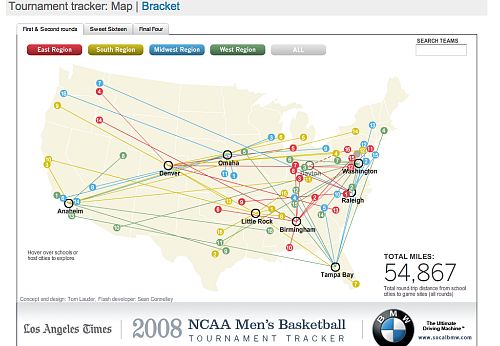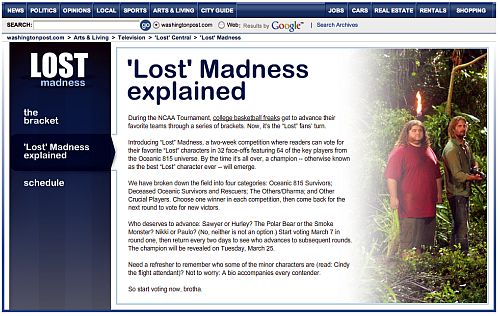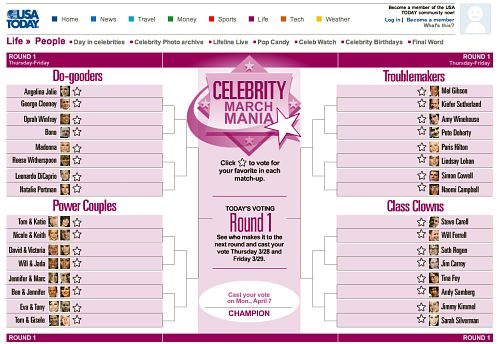For those of you not spending the day at work watching NCAA basketball tournament games (or for those bored by an inevitable first-round blow-out), let’s take a look at a few innovative online projects that newspapers have created to build traffic off public interest in the annual college playoffs.
Many newspaper websites offer contests in the week leading up to the tournament, inviting readers to fill out the 65-team tournament bracket with their picks for winners in each of the games. It’s the (legal) online version of the ever-opular office betting pools, with the not-so-legally-insignificant difference that the prizes are coming from sponsors and not money put up by the participants.
That’s fine. It drives some traffic, and people like making picks without having to put any of their own skin in the game. But everyone’s doing that. What else is out there?
I found a few interesting examples.
First, the Los Angeles Times offered an option on its Flash tournament brackets that I’d not seen before:
It’s a geographic map that shows where each of the 65 teams are traveling from and to for the first-round matchups. The NCAA sends teams flying all over the country in an effort to balance the competitive level in each of its tournament regions. I found it fascinating to see, in one glance, just how far some teams have to go. Plus, this graphic provides a handy way to answer the inevitable first-round question: “I’ve never heard of that school; where is it from again?”
Click on the “Bracket” option at the top of the graphic, and you return to the traditional bracket chart, which readers can fill out by clicking team names.
The Washington Post and USA Today produced their own NCAA tournament webpages, but what caught my eye is how they also spun the idea of filling out a tournament bracket and applied that to different forms of entertainment.
The Post got a head start by starting earlier this month a single-elimination tournament pitting characters from the TV show “Lost” against one another. Readers voted for the characters they thought would survive in each head-to-head match-up.
USA Today seeded 64 entertainment celebrities and celebrity couples and created a reader-vote tournament to find the “winner”:
The WaPo and USAT tournaments exemplify the power of reader interactivity. Sure, they are fluff. But they, like the interactive NCAA tournament brackets, are fluff that get people reading, clicking and spending time on their newspapers’ websites.
Industry veteran Vin Crosbie last week pointed out on Poynter’s online-news e-mail list that U.S. newspapers have a huge problem in eliciting repeat visits from their online readers:
“If you download the NAA’s spreadsheet of the N//N data and calculate medians, you’ll see that the median user of those top 100 U.S. newspaper sites visited only 2.58 times per month and saw only 15.03 Web pages on a newspaper site per month. That’s not much: a visit only once every 11.6 days and 15 Web pages all month.”
My wife is fond of citing her Suzuki violin training that “it takes 21 days to form a habit.” (“And 12 steps to break it,” I shot back the first time she told me this.) Whether habits form in 21 days or not, website publishers help their readership numbers by creating features that inspire readers to come back to a site, and reward them for doing so, day after day.
A reader-vote tournament, such as the Post’s and USA Today’s, does this. Unlike traditional online polls, these build upon each other, sending the winners in one day’s poll on to the next’s, inspiring readers to return. Unlike the NCAA tournament, which you can follow on TVs, websites, cell phones and newspapers, these tournaments are available only on their creators’ websites. So you gotta come back there to vote, and to see who won in each round.
Take it a step further: Include each day’s match-ups and results in one of your daily update e-mails, and invite those readers following the tournament to subscribe to it. I’ll bet you many of them continue to get and read that daily e-mail, finding other news and features on your site, even after the tournament’s done.
If you want people reading the great reporting on your news website, first, you’ve got to get them in the habit of coming to the site. Don’t overlook the value of interactive reader-driven online events, such as these, in helping you to do that.











